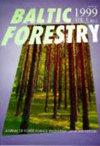Integration of statistical forest reflectance model and Sentinel-2 MSI images into a continuous forest inventory system
IF 0.6
4区 农林科学
Q3 FORESTRY
引用次数: 0
Abstract
Spectral signatures of forest stands in Sentinel-2 MSI spectral bands are simulated with the statistical forest reflectance (SFRM) model and compared to the spectral signatures measured in spectral images at ten study sites in Estonia. As an overall measure of the agreement between simulated and measured spectral signatures we used the total error calculated as the sum of relative errors over spectral bands B2 to B11 of Sentinel-2. The distribution of the total error has strongly positive skewness at all study sites and all types of forests (broadleaf, pine and spruce forests). The right tail of the distribution is low. The stands of high value of the total error far right in the tail of the distribution may have some errors in their inventory data, or the inventory data are outdated. Pertinent stands should have priority in their in situ checking process. The SFRM model is a simple and reliable tool for the validity checking of forest inventory data, using routinely collected forest inventory data and operational satellite information of moderate spatial resolution. The model is simple and computationally efficient. Preparing input data for the model is a simple query in the forest inventory database. The suggested procedure can be incorporated into the automated systems of continuous forest inventory. Keywords: Forest inventory, Sentinel-2 MSI images, Statistical forest reflectance model将统计森林反射率模型与Sentinel-2 MSI图像集成到连续森林清查系统中
利用统计森林反射率(SFRM)模型模拟了Sentinel-2 MSI光谱波段森林林分的光谱特征,并与爱沙尼亚10个研究地点的光谱图像测量的光谱特征进行了比较。作为模拟光谱特征与实测光谱特征之间一致性的总体度量,我们使用了Sentinel-2光谱波段B2至B11相对误差之和计算的总误差。在所有研究点和所有类型的森林(阔叶林、松林和云杉林)中,总误差的分布具有强烈的正偏性。分布的右尾是低的。分布尾部总误差极值较高的摊位,其库存数据可能存在一定的误差,或者库存数据已经过时。有关的立足点在其现场检查过程中应具有优先权。SFRM模型是一种简单可靠的森林清查数据有效性检验工具,它使用常规森林清查数据和中等空间分辨率的卫星运行信息。该模型简单,计算效率高。为模型准备输入数据是森林库存数据库中的一个简单查询。建议的程序可纳入连续森林清查的自动化系统。关键词:森林清查,Sentinel-2 MSI图像,统计森林反射率模型
本文章由计算机程序翻译,如有差异,请以英文原文为准。
求助全文
约1分钟内获得全文
求助全文
来源期刊

Baltic Forestry
农林科学-林学
CiteScore
1.60
自引率
0.00%
发文量
23
审稿时长
>12 weeks
期刊介绍:
The journal welcomes the original articles as well as short reports, review papers on forestry and forest science throughout the Baltic Sea region and elsewhere in the area of boreal and temperate forests. The Baltic Sea region is rather unique through its intrinsic environment and distinguished geographical and social conditions. A temperate climate, transitional and continental, has influenced formation of the mixed coniferous and deciduous stands of high productivity and biological diversity. The forest science has been affected by the ideas from both the East and West.
In 1995, Forest Research Institutes and Universities from Estonia, Latvia and Lithuania
joined their efforts to publish BALTIC FORESTRY.
 求助内容:
求助内容: 应助结果提醒方式:
应助结果提醒方式:


